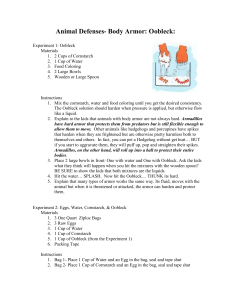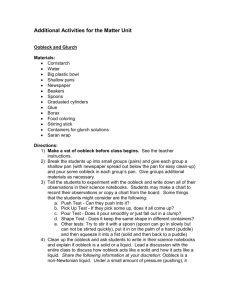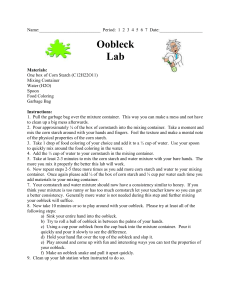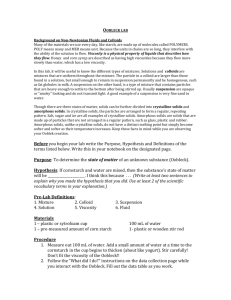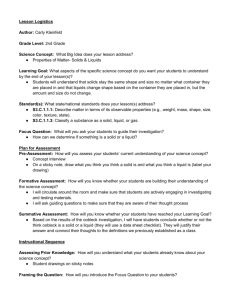Experimental Design - New Jersey Center for Teaching and Learning
advertisement
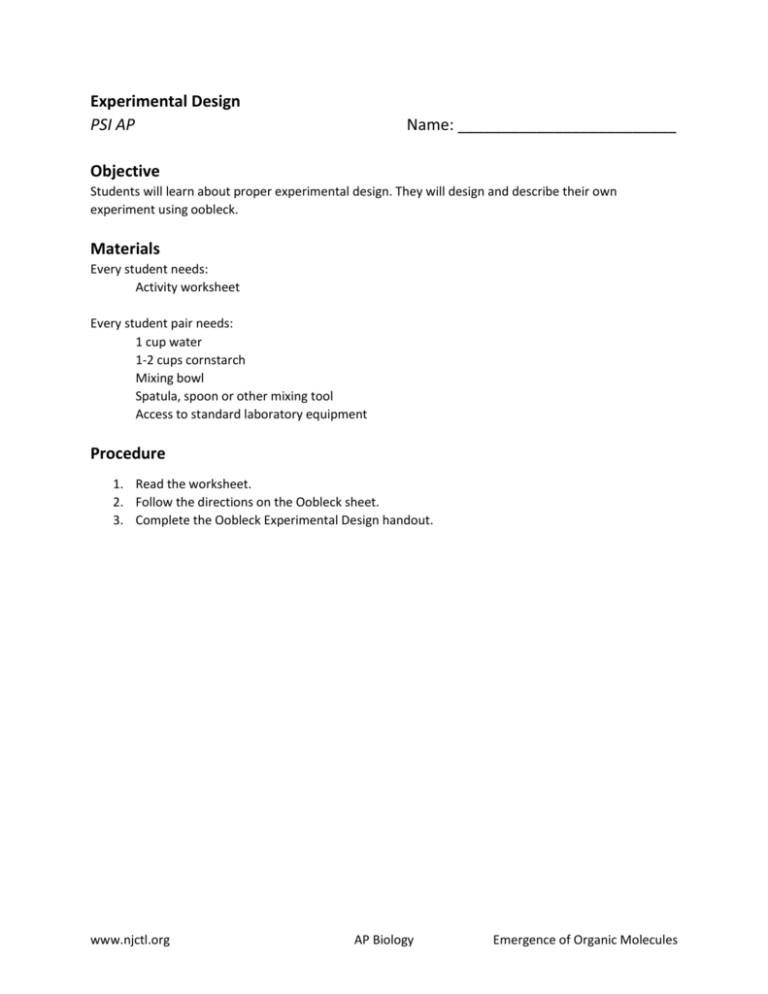
Experimental Design PSI AP Name: _________________________ Objective Students will learn about proper experimental design. They will design and describe their own experiment using oobleck. Materials Every student needs: Activity worksheet Every student pair needs: 1 cup water 1-2 cups cornstarch Mixing bowl Spatula, spoon or other mixing tool Access to standard laboratory equipment Procedure 1. Read the worksheet. 2. Follow the directions on the Oobleck sheet. 3. Complete the Oobleck Experimental Design handout. www.njctl.org AP Biology Emergence of Organic Molecules Experimental Design All of the information in your science textbook is the result of critical thinking backed up by results from scientific experiments. Scientific thinking follows the following process: Scientific Process Observations Question Background research Hypothesis Experiment Analyze results Report findings www.njctl.org AP Biology Emergence of Organic Molecules In order for experiments to be valuable to the scientific community, they must adhere to accepted guidelines for experimental design, including the following aspects. Experimental Design Variables • Independent • What is manipulated • Dependent • What is measured • Controlled • What is kept constant Control group • A group that receives no treatment in the experiment so that the results can be compared to something. Experimental groups • Also called "treatments". • The groups that undergo manipulated conditions. Accuracy • Are the experimental results close to the known values? • Achieved by taking careful measurements and adhering to procedure Reliability • Are the results precise? • Can the experiment be duplicated with the same results over and over again? • Achieved by: • Duplicating the experiment several times and averaging the results • Using large sample sizes and averaging the results Sources of Error • Events that happened during the experiment that may have skewed the results. www.njctl.org AP Biology Emergence of Organic Molecules Example: The effect of sunlight on gardenia flowers Observation: Your father hangs gardenias from the front patio roof, which enjoys a few hours of morning sunshine. Despite the fact that he waters them every day, they are drooping within a week and the flowers have completely fallen off. You tell him that they need more sunlight, but he does not believe you. Question: How much sunlight do gardenias require? Background research: A trip to the local gardening center teaches you that gardenias are supposed to have “full light”, which means more than 6 hours of sunlight per day. Hypothesis: Gardenias placed in full sunlight on the front porch will sprout more flowers than gardenias hung from the patio roof in partial sunlight. Experiment: You hang 3 gardenias from patio roof, place 3 gardenias on the porch steps, and 3 gardenias inside the house. The patio roof receives 2 hours of sunlight each day while the porch steps receive 8 hours of sunlight each day and the inside plants receive no direct sunlight. They are planted in identical pots with identical fertilizer. You give them two cups of water per day. At the end of each day, you count how many flowers are present on each plant. You continue this for 4 weeks. Independent variable: Amount of sunlight Dependent variable: # of flowers Controlled variables: pot, fertilizer, amount of water Control group: gardenias placed inside the house Experimental groups: gardenias hung from patio roof and placed on the porch steps # of treatments: 2 (patio roof and porch steps) Sample size: 3 (3 gardenias per location) Analyze results: You tabulate your results in a bar graph, which shows that the gardenias on the porch steps grew the most flowers. Since all other conditions except sunlight were the same for all flowers, you conclude that gardenias require a lot of sunlight to produce healthy flowers. How accuracy was achieved: You were precise in all your measurements and procedures. How reliability was achieved: You used a sample size greater than one and averaged the results Sources of error: You forgot to water the plants on two occasions: day 18 and day 24. On day 13, there was a short rain shower that watered the gardenias on the porch steps but not the other locations. Report findings: You explain the results to your father. He is so impressed that he buys you a new car. www.njctl.org AP Biology Emergence of Organic Molecules Oobleck! Now that you are an expert in the scientific process and experimental design, it is your turn to create an experiment with oobleck, a non-Newtonian fluid. Non-Newtonian fluids are pressure-dependent substances. Procedure: 1. In the mixing bowl, stir together 1 cup water and 1 cup cornstarch. 2. Slowly add more cornstarch into the mixture. Observe the qualities of your oobleck as you mix. It will take between 1.5 and 2 cups of cornstarch to achieve the perfect oobleck consistency. 3. Observations: Slowly place your finger into the oobleck. What do you notice? Quickly punch the oobleck. What do you notice? A Non-newtonian fluid sometimes acts like a liquid and sometimes acts like a solid. How does oobleck fit into this description? 4. Based on your observations, come up with a question that you would like to answer about oobleck. You have access to all the basic laboratory equipment to use in your experiment. 5. Fill out the Oobleck Experimental Design on the next page as your work through your experiment. www.njctl.org AP Biology Emergence of Organic Molecules Oobleck Experimental Design Observation Question Hypothesis Experiment Summary of procedure: Independent variable: Dependent variable: Controlled variables: Control group: Results Summary of results: How was accuracy achieved? How was reliability achieved? Sources of error (list at least 2): www.njctl.org AP Biology Emergence of Organic Molecules

